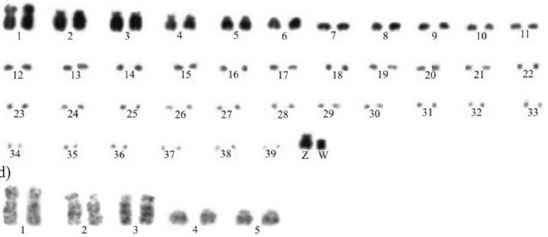NOR- bearing as a plesiomorphic characteristic in Mimus saturninus (Passeriformes Mimidae)
DOI:
https://doi.org/10.20873/jbb.uft.cemaf.v5n2.kretschmerPalabras clave:
cariotipo, macro y microcromosomas, bandas cromosómicasResumen
The order Passeriformes is the largest group of species karyotyped among birds, however little is known about the cytogenetic of the Mimidae family, registering only karyology basic data (giemsa staining). The aim of this study was to analyze the chromosomal complement from the species Mimus saturninus by conventional staining and differential chromosome banding. Diploid number and chromosome morphology were determined, as well as the distribution pattern of constitutive heterochromatin (CBG-banding), GTG-banding andAgNOR staining (NORs). The Chalk-browed Mockingbird has 2n=80. The first and fourth pairs are submetacentric and the second, third and fifth are acrocentric. The remaining chromosomes pairs of the complement have telocentric morphology. The Z chromosome is submetacentric and the W is metacentric. CBG-banding showed positive staining in the pericentromeric region of most macrochromosomes and microchromosomes and also at Z chromosome, differently from W chromosome which appeared totally heterochromatic. The GTG-banding was similar to Gallus gallus and in other species which have already been GTG-banded. The NORs were identified in a pair of microchromosomes characterized by presenting a remarkable secondary constriction. This can be considered as a plesiomorphic characteristic for M. saturninus once baseline groups (Paleognathae) also showed a pair of microchromosomes bearing NORs.

Descargas
Publicado
Cómo citar
Número
Sección
Licencia
Copyright (c) 2024 - Journal of Biotechnology and Biodiversity

Esta obra está bajo una Licencia Creative Commons Atribución 4.0 Internacional.
Los autores que publican en esta revista aceptan los siguientes términos:
Los autores mantienen los derechos autorales y conceden a la revista el derecho de primera publicación, con el trabajo simultáneamente licenciado bajo la LicenciaCreative Commons Attribution (CC BY 4.0 en el link http://creativecommons.org/licenses/by/4.0/) que permite compartir el trabajo con reconocimiento de la autoría y publicación inicial en esta revista.
Los autores tienen autorización para asumir contratos adicionales separadamente, para distribución no exclusiva de la versión del trabajo publicado en esta revista (ej.: publicar en repositorio institucional o como capítulo de libro), con reconocimiento de autoría y publicación inicial en esta revista.
A los autores se les permite, y son estimulados, a publicar y distribuir su trabajo online (ej.: en repositorios institucionales o en su página personal) en cualquier punto antes o durante el proceso editorial, ya que esto puede generar alteraciones productivas, bien como aumentar el impacto y la citación del trabajo publicado (disponible en El Efecto del Acceso Libre en el link http://opcit.eprints.org/oacitation-biblio.html).


